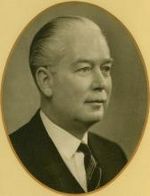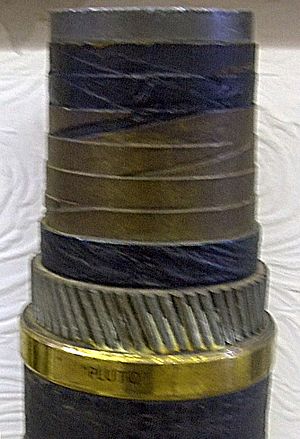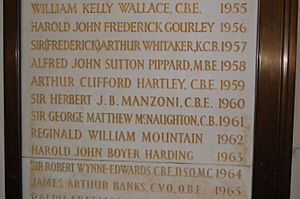Arthur Hartley facts for kids
Quick facts for kids
Arthur Hartley
|
|
|---|---|
 |
|
| Born | 7 January 1889 |
| Died | 28 January 1960 (aged 71) St Thomas's Hospital, London,
|
| Nationality | English |
| Education | City and Guilds College |
| Occupation | Engineer |
| Spouse(s) | Dorothy Wallace and Florence Hodgson |
| Children | four sons |
| Engineering career | |
| Discipline | Civil |
| Institutions | Institution of Civil Engineers (president), Institution of Mechanical Engineers (president) City and Guilds of London Institute (honorary fellow) |
| Projects | FIDO, Operation Pluto |
| Awards | Medal of Freedom |
Arthur Clifford Hartley (born January 7, 1889 – died January 28, 1960) was a brilliant British civil engineer. He is famous for his important inventions during World War II. These include the FIDO fog dispersal system and the PLUTO pipelines.
Hartley studied engineering at Imperial College London. After college, he worked for a railway company and an asphalt maker. During World War I, he joined the Royal Flying Corps. He became a pilot and helped develop a special device for aircraft machine guns. This device allowed guns to fire safely through propeller blades.
After the war, he worked as a consultant. Later, he joined the Anglo-Persian Oil Company. His work during World War II earned him high honors. These included the CBE and the American Medal of Freedom. He also received a large cash award for his inventions.
Contents
Arthur Hartley's Early Life
Arthur Hartley was born in Hull, England, on January 7, 1889. His father, George Thomas Hartley, was a surgeon. Arthur went to Hymers College and Hull Municipal Technical College.
He then studied engineering at the City and Guilds College. This college is part of Imperial College London. In 1910, he earned his engineering degree. After graduating, he worked for the North Eastern Railway. He also worked for a company that made asphalt.
Hartley in World War I
During the First World War, Arthur Hartley joined the Royal Flying Corps. He became a second lieutenant in August 1916 and learned to fly planes. By the end of the war, he was a major.
Hartley worked on weapons for the Air Board. He helped develop a special device called interrupter gear. This invention allowed machine guns on planes to shoot between the spinning propeller blades. This meant pilots could aim directly at their targets without hitting their own propellers. Many believed this invention helped British planes gain an advantage in the air.
After the war, he was recognized for his important work. He was made an Officer of the Order of the British Empire (OBE) in 1919.
Working Between the Wars
After World War I, Hartley worked as a consulting engineer for five years. In 1924, he joined the Anglo-Persian Oil Company. He started as an assistant manager in their engineering division.
Later that year, he moved to the supply department. From 1932 to 1934, he worked for the Iraq Petroleum Company. When he returned, he became the chief engineer for Anglo-Persian Oil. This company later changed its name to Anglo-Iranian Oil Company in 1935.
Hartley's Role in World War II
When Second World War started, Hartley was asked to help the government. In 1940, he joined the Ministry of Aircraft Production. He helped create a special bombsight between 1940 and 1941. This bombsight was used by RAF Bomber Command to sink the German battleship Tirpitz in 1944.
From 1942, Hartley worked for the Petroleum Warfare Department. He became its technical director. Here, he developed two very important projects:
- FIDO (Fog Investigation and Dispersal Operation): This system helped clear fog from airport runways. It worked by burning oil along the runways, which made the fog disappear. FIDO was installed at fifteen airfields in Britain starting in 1943. It helped 2,500 aircraft and 10,000 aircrew land safely during the war.
- Operation PLUTO (Pipe Lines Under The Ocean): Hartley also designed the pipes used for this project. PLUTO was a series of twenty-one pipelines laid under the English Channel. These pipes carried fuel from Britain to the Allied armies fighting in Europe. The system supplied a huge amount of fuel every day. This helped the Allied forces advance into Germany.
For his amazing work on PLUTO, Hartley received £9,000 after the war. He was also appointed a Commander of the Order of the British Empire (CBE) in 1944.
After the War
In 1946, Arthur Hartley received the United States Medal of Freedom. He retired from Anglo-Iranian Oil Company in 1951. This company later became British Petroleum.
After retiring, he worked as an engineering consultant. He even invented the Hartley hoister. This device made it easier to load oil tankers offshore. In 1951, he was elected president of the Institution of Mechanical Engineers. He also became an honorary fellow of the City and Guilds of London Institute and Imperial College London.
In 1959, he was elected president of the Institution of Civil Engineers. Sadly, he passed away just three months into his term. He died at St Thomas's Hospital in London on January 28, 1960.
Arthur Hartley's Family Life
Arthur Hartley married Dorothy Elizabeth Wallace in 1920. She was the daughter of a marine engineer from Shanghai. They had two sons together. Dorothy passed away in 1923.
In 1927, he married Florence Nina Hodgson. With Florence, he had two more sons.



